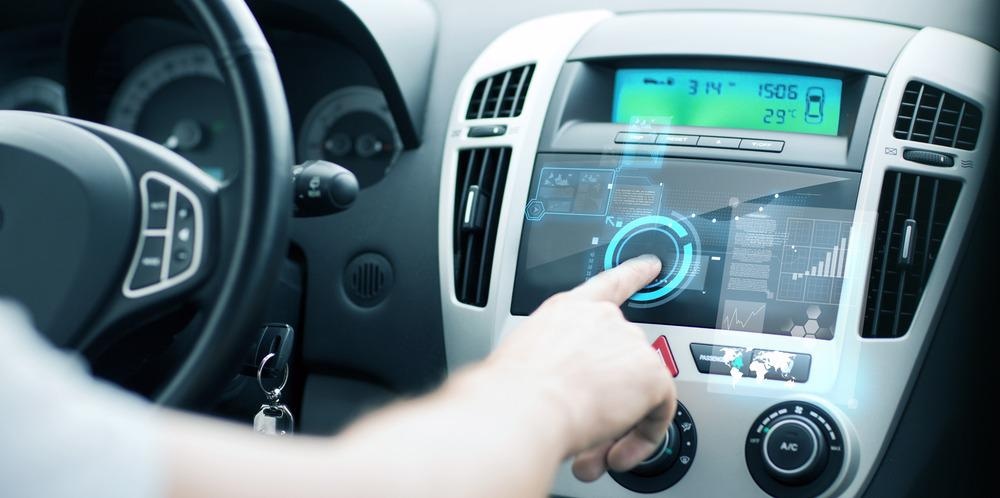Given the rate of recent technological advancements and transitions, this is a thrilling moment in the automotive industry, with countless emerging possibilities.

Image Credit: Syda Productions/Shutterstock.com
Flexible electronics is one area of technology that holds significant promise for the industry. The demand for printed, flexible electronics in the industry over the decade will rise to $13 billion, according to a 2021 report from IDTechEx. The use of thin electronics on flexible substrates will be driven by the need to reduce weight, a primary concern for the production of electric vehicles. The conformality of flexible electronics is also well-suited to emerging tastes in automotive interior design that prefer organic curves over flat surfaces.
There are currently several areas that utilize flexible electronics made with conductive inks and various printing technologies.
Interactive Interior Features
Manufacturers are more frequently utilizing interior features to differentiate between their models and those of other brands with the addition of multiple displays. To this end, a recent prototype from Novares makes use of exterior revolving mirrors, cameras, augmented reality technology, and a flexible display to offer 360-degree views around the vehicle. The display system informs and reassures drivers with all-around vision. Fabricated with a plastic substrate, the flexible display can be tilted towards a viewer and has a bending radius of almost 15 mm.
Used to replace mechanical knobs and switches, smart surfaces use capacitive touch sensors and integrated lighting. This is based on in-mold electronics (IME), which combine electronic, ornamental, and mechanical characteristics into a single part. IME are made by using screen-printing conductive traces and incorporating surface-mount devices onto a film. Thermoforming and injection molding processes are then used to complete the fabrication method.
IME facilitate multifunctional interior parts. Center consoles and overhead instrument panels can be much lighter, less complicated, and easier to fabricate. Another advantage is the decoupling of form and functionality. This simplifies 'versioning' because the same molds could be used to produce parts with different looks and capabilities. Furthermore, IME facilitates new use cases, including incorporating electronic and touch-sensitive features into the rears of front seats. International automotive company Faurecia is currently developing IME-based consoles and features.
Used to add electronics into plastic structures, plastronics is changing the interior design of vehicles. Faurecia is also committing to a broad range of plastronic businesses and looking at ways to integrate the technology into flexible electronic solutions. Finland-based Canatu and Germany-based Continental are developing clear, 3D touch surfaces for automotive interiors based on conductive films and sensors.
3D-printed pressure sensors are also being applied to control panels to offer a broader range of possible inputs. As for occupancy sensors, these are evolving into a multipoint sensor system that is distributed all over the seat fabric to better keep track of passenger comfort.
Heating
The prevailing way of heating a vehicle interior by sending hot air out of vents is rather inefficient and very damaging to the range of an electric vehicle. Flexible electronics that incorporate heating elements at strategic touchpoints are substantially more efficient. This radiative heating system could be applied to seats, steering wheels, armrests, and center consoles. In addition, the nature of printed electronics allows for heaters to be put within the exterior, which makes a heating system more responsive and efficient. Heating elements could also be made more visible using transparent conductors.
Canatu is also working on such a heating system based on a film made from a proprietary blend of carbon nanotubes and fullerenes.
Battery Monitoring and Heating for Electric Vehicles
Offering the maximum value minimal weight and cost is a primary concern for electric vehicle manufacturers. For batteries, this means always working as effectively as possible, and battery capacity is strongly determined by temperature. Arrays of flexible, printed temperature sensors that can offer battery monitoring and heating elements could be incorporated into the same film. Temperature sensors can also detect sudden increases in temperature that indicate a malfunction or safety concern.
Integrated Antennas
Vehicles are becoming more connected every day, and this increasing connectivity requires multiple antennas to handle several frequency bands. Using flexible electronics, antennas can be built into body panels and other surfaces, opening up possibilities for IME and 3D surface applications.
Researchers at the Georgia Institute of Technology and Boeing are currently working on a flexible array antenna that may be built into the body of a vehicle. The partnership is looking to fabricate large, broadband arrays by printing silver, carbon nanostructures, and magnetic materials into layers of flexible substrates. The goal is to expand antenna technologies and enable flexible, millimeter-wave broadband wireless solutions, including the development of so-called "smart skins".
Resources and Further Reading
IDTechEx. Printed and Flexible Electronics for Automotive Applications 2021-2031: Technologies and Markets. [online] Available at: https://www.idtechex.com/en/research-report/printed-and-flexible-electronics-for-automotive-applications-2021-2031-technologies-and-markets/806
Savastano, D. Flexible and Printed Electronics and the Automotive Market. Printed Electronics. [Online] Available at: https://www.printedelectronicsnow.com/contents/view_online-exclusives/2019-02-12/flexible-and-printed-electronics-and-the-automotive-market/
Weber, A. Flexible, printed electronics offer lightweight alternative. Assembly. [Online] Available at: https://www.assemblymag.com/articles/93891-flexible-printed-electronics-offer-lightweight-alternative
Disclaimer: The views expressed here are those of the author expressed in their private capacity and do not necessarily represent the views of AZoM.com Limited T/A AZoNetwork the owner and operator of this website. This disclaimer forms part of the Terms and conditions of use of this website.